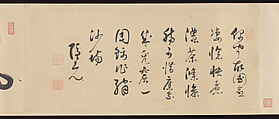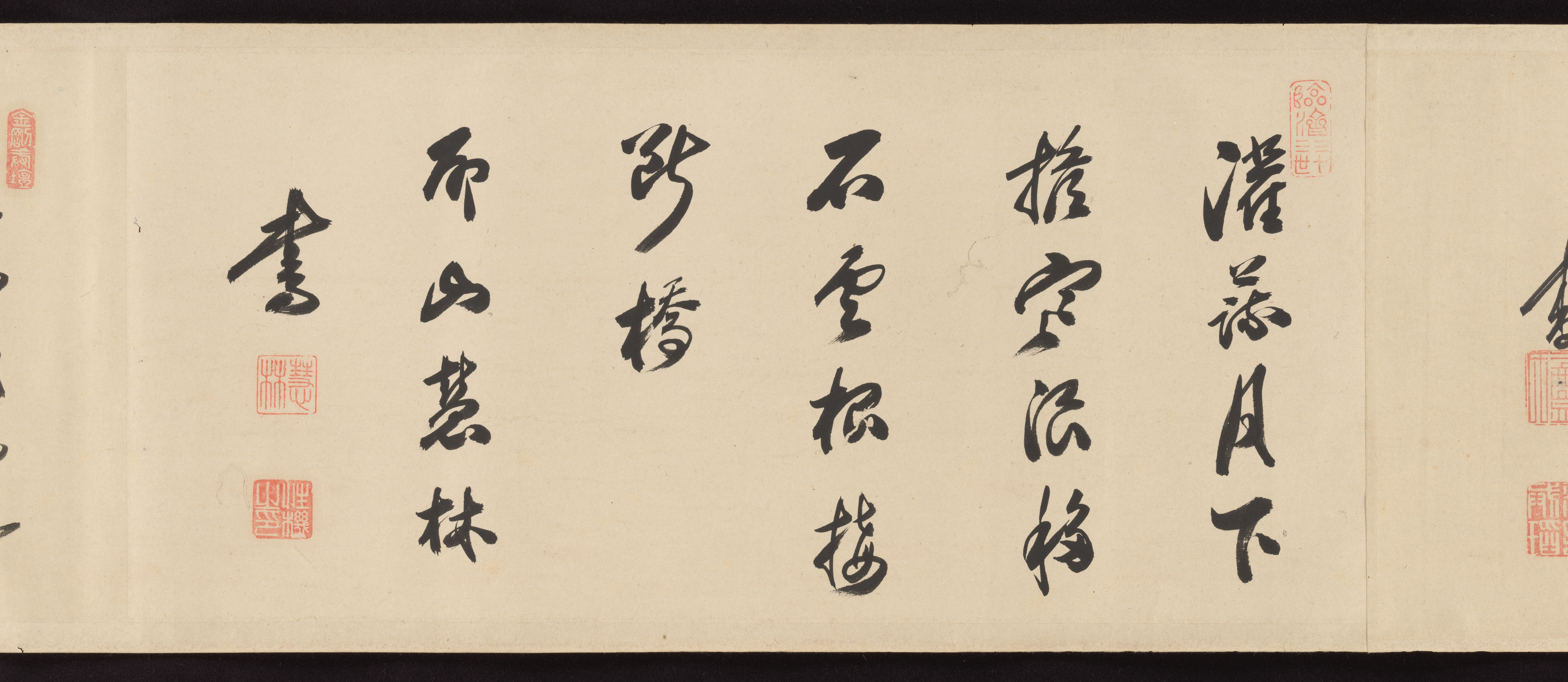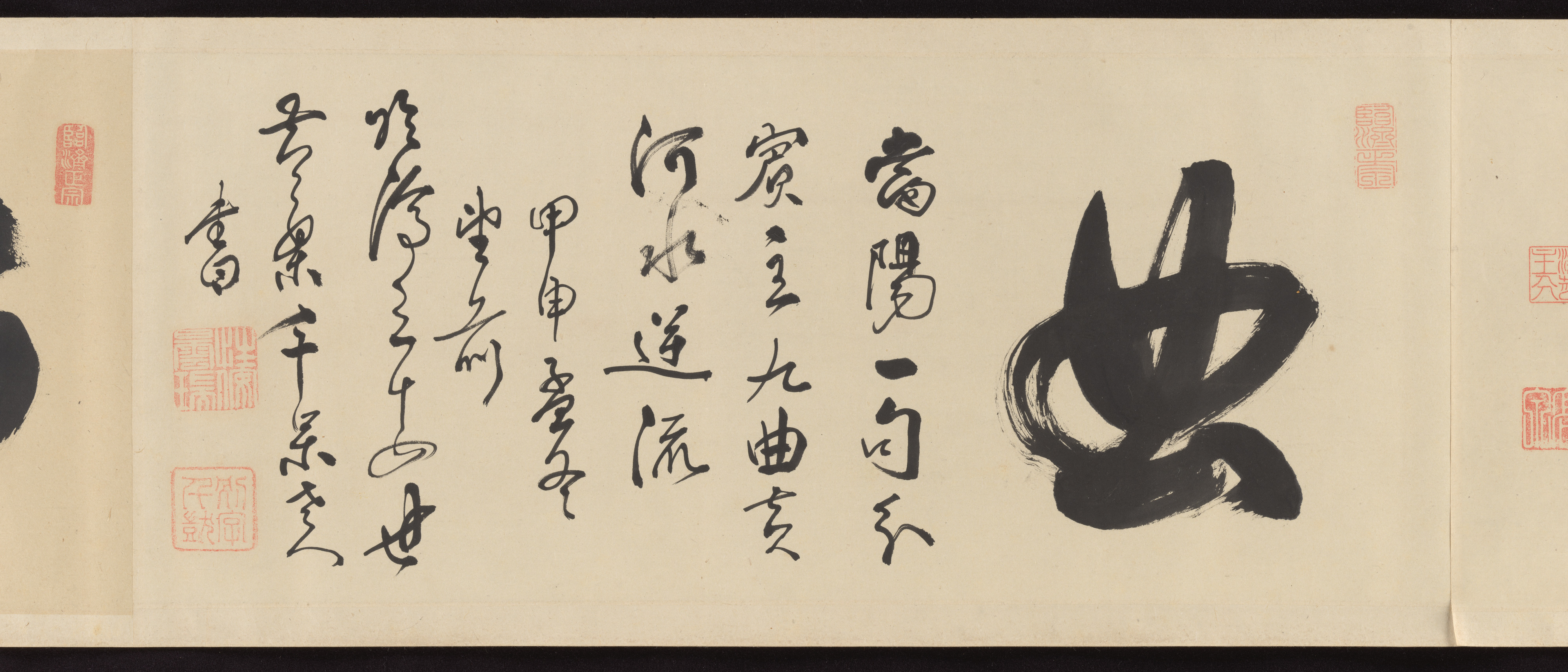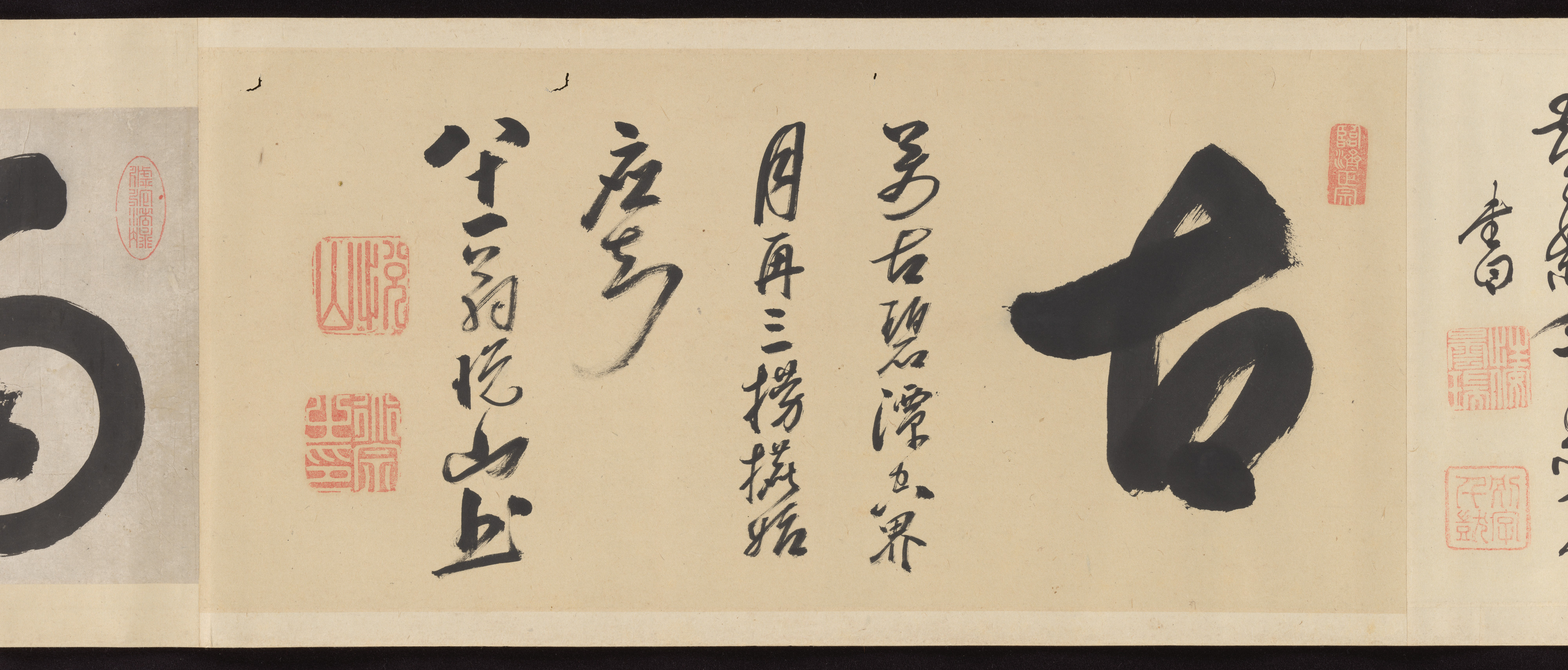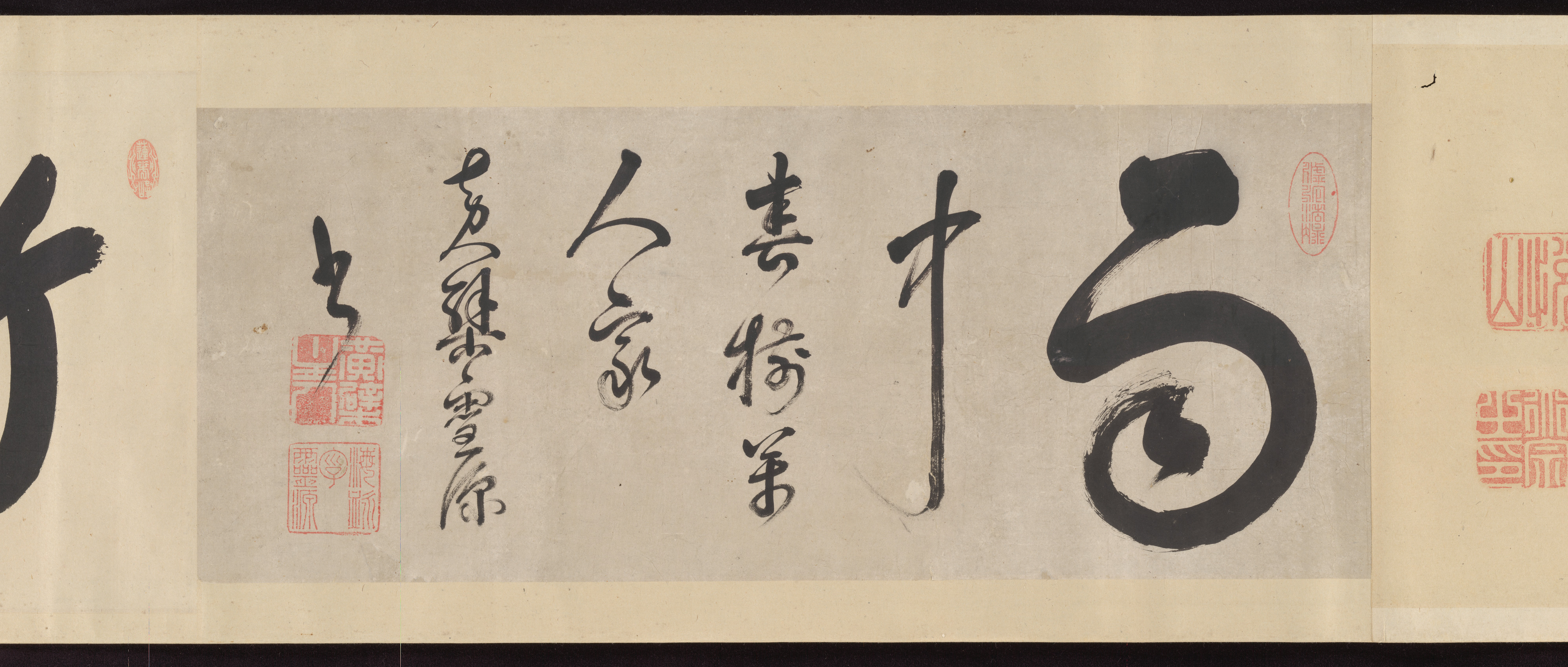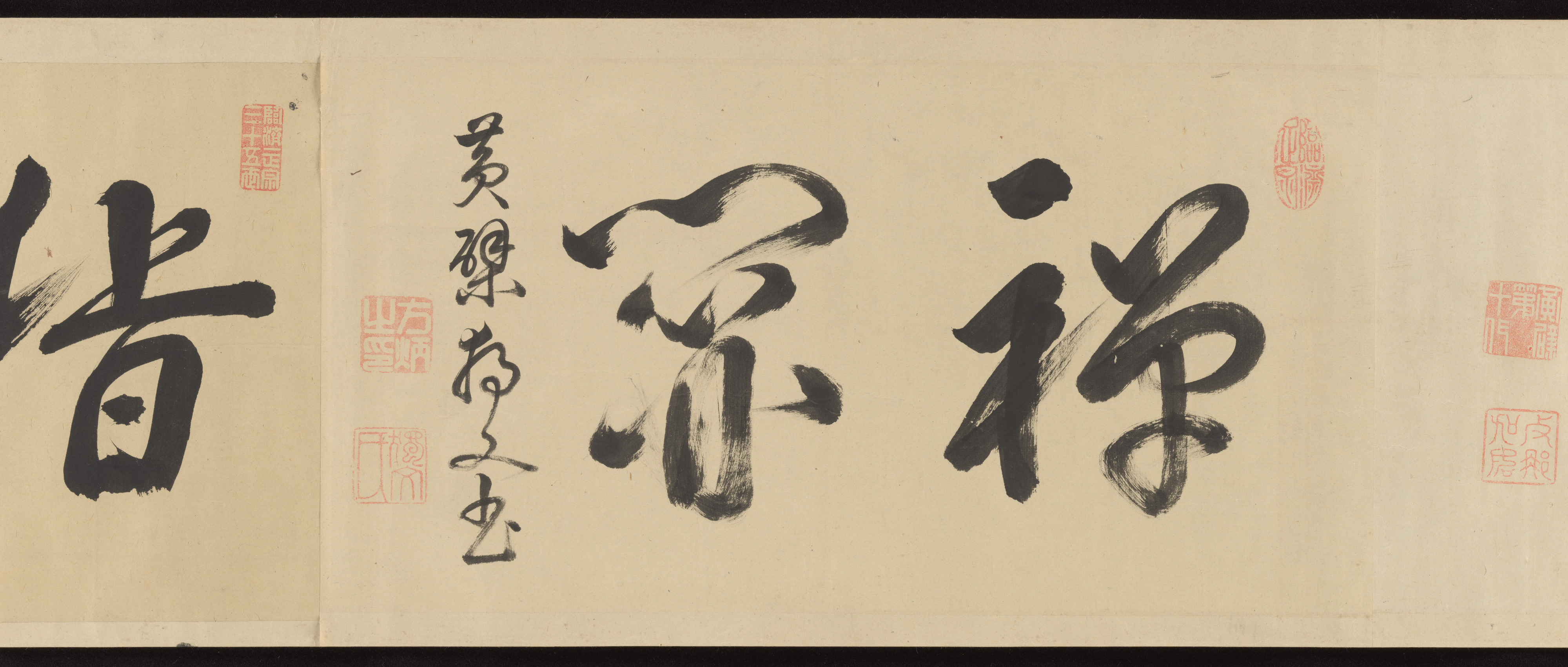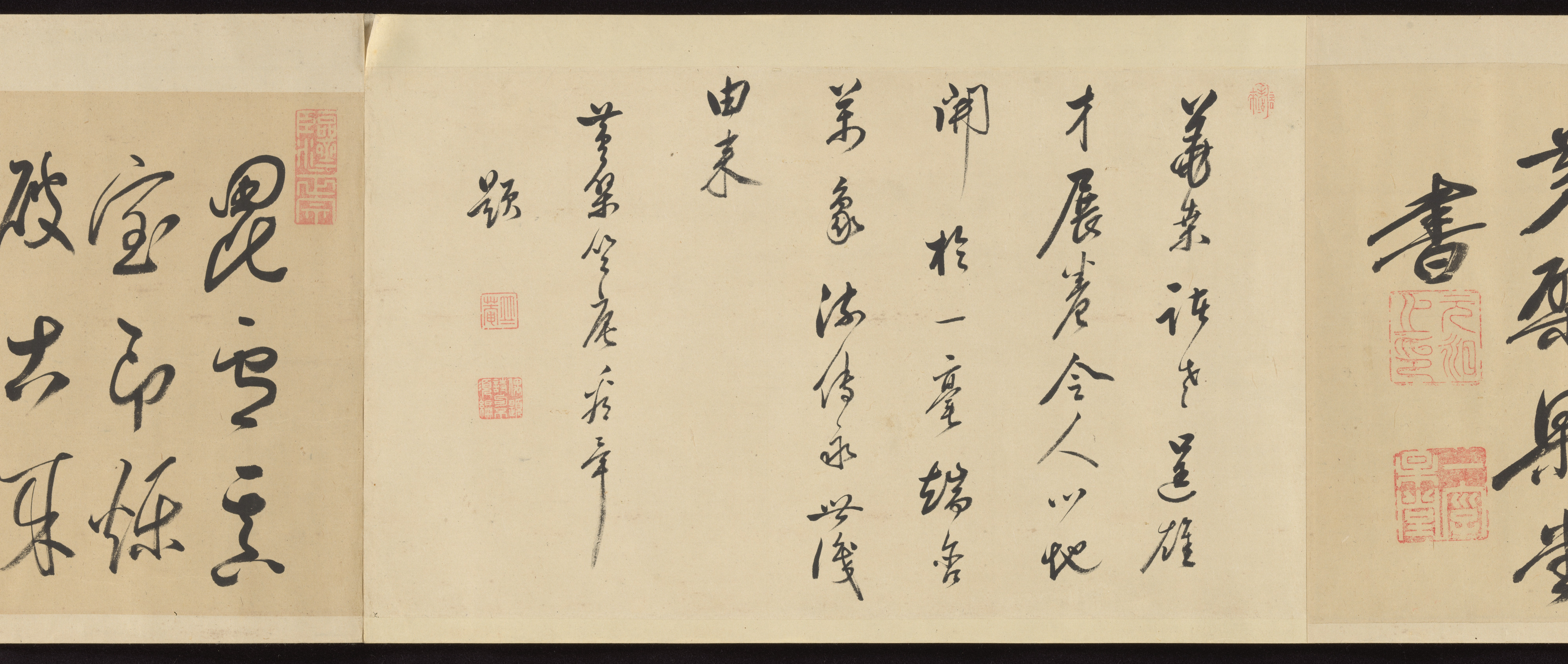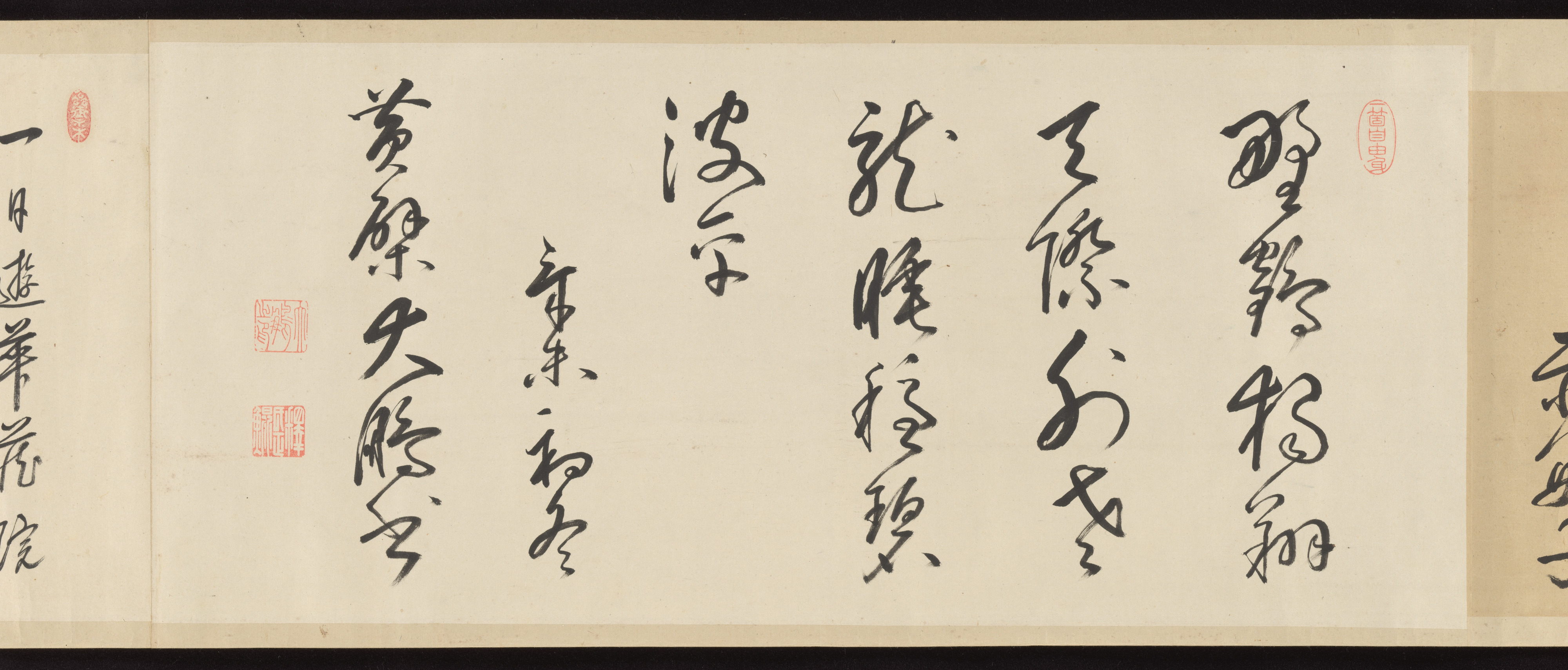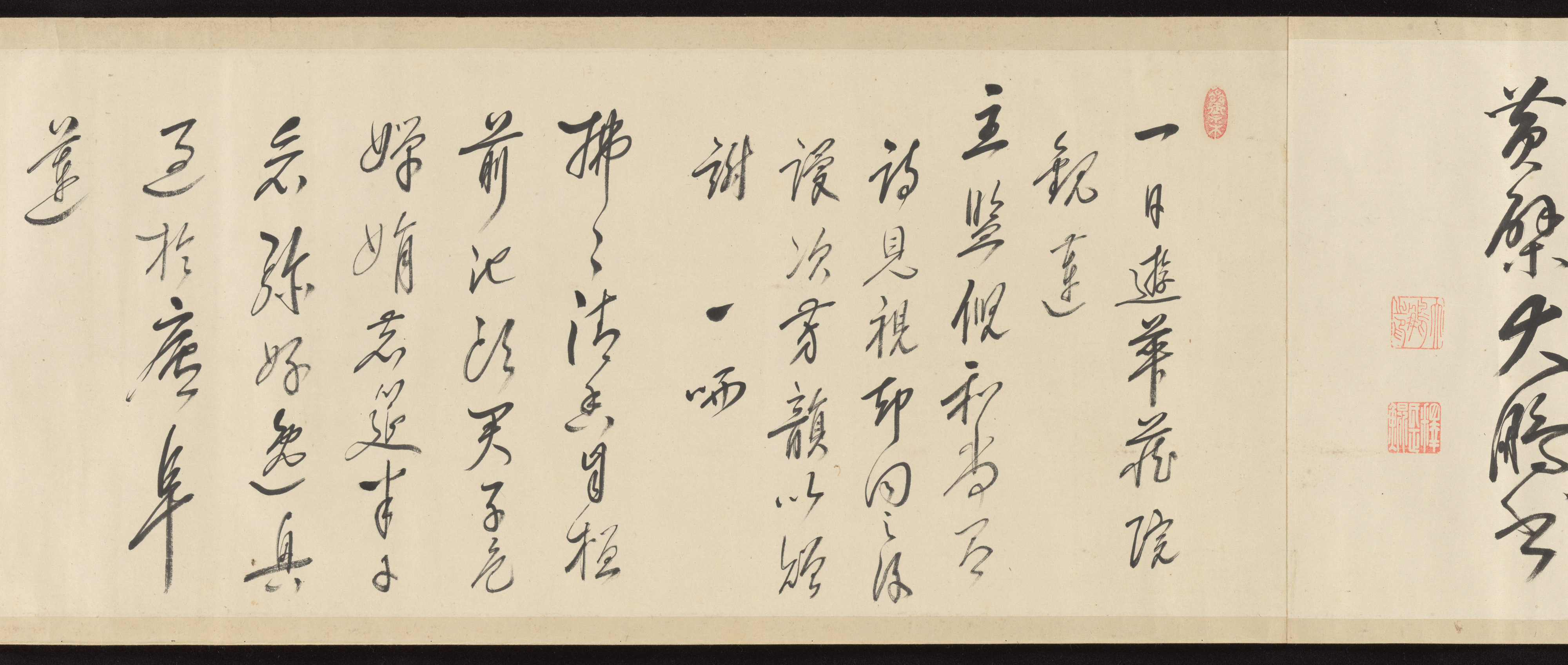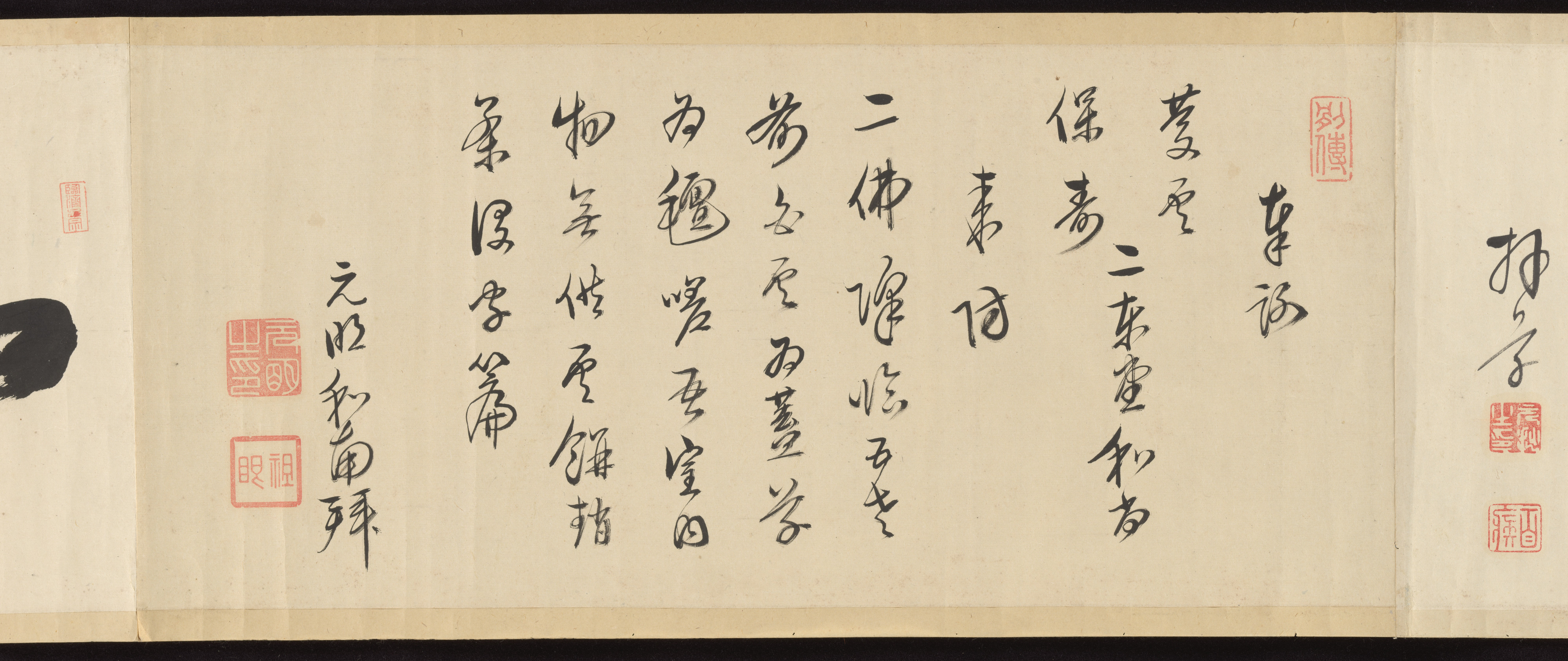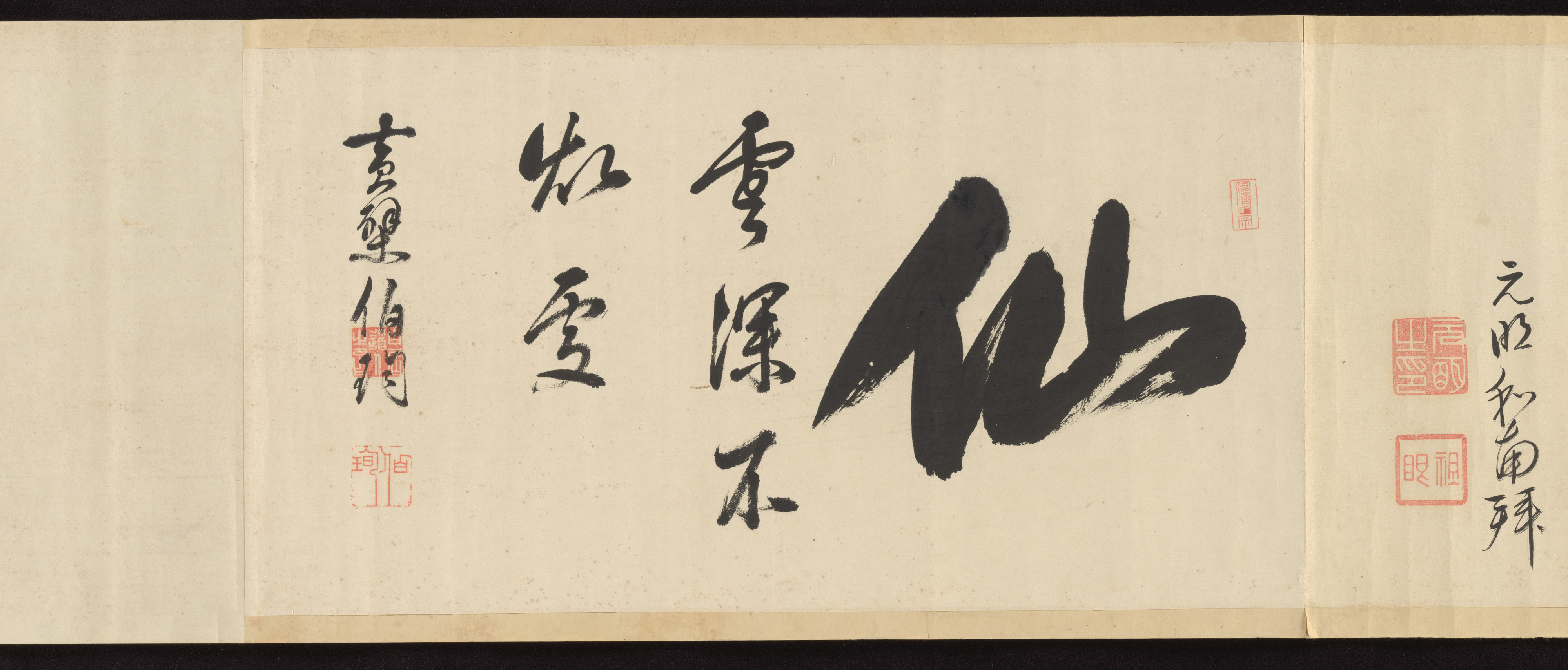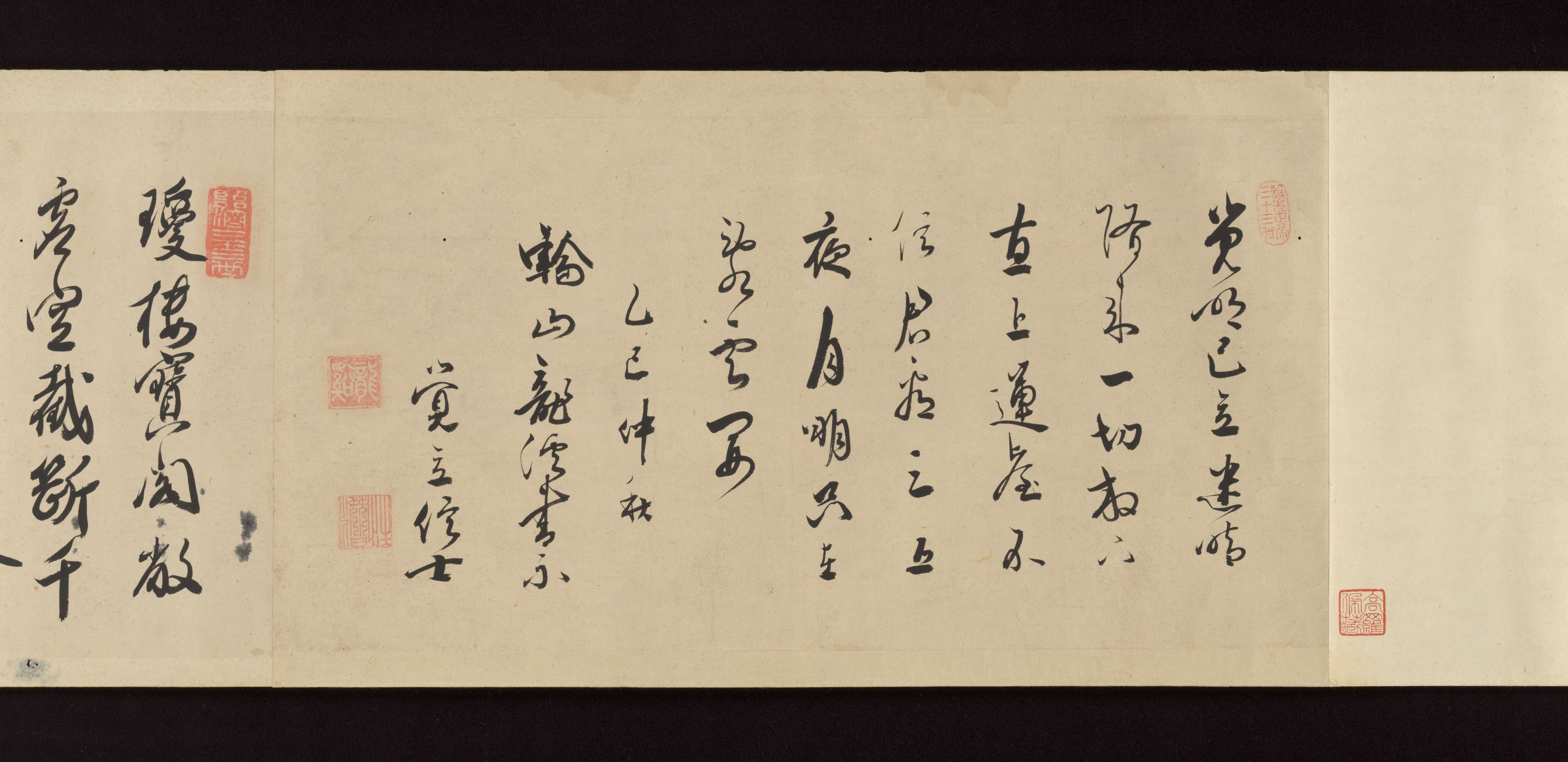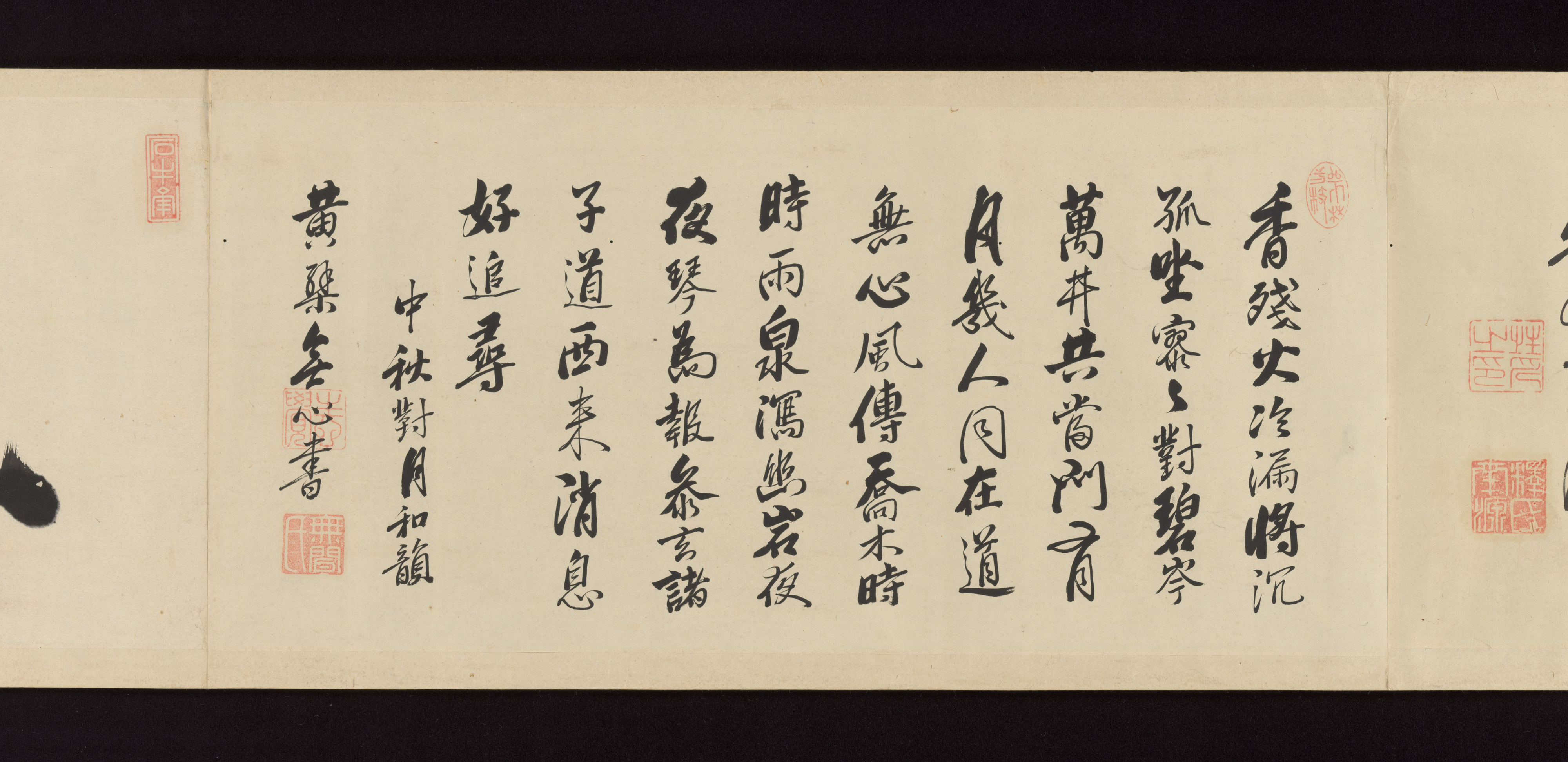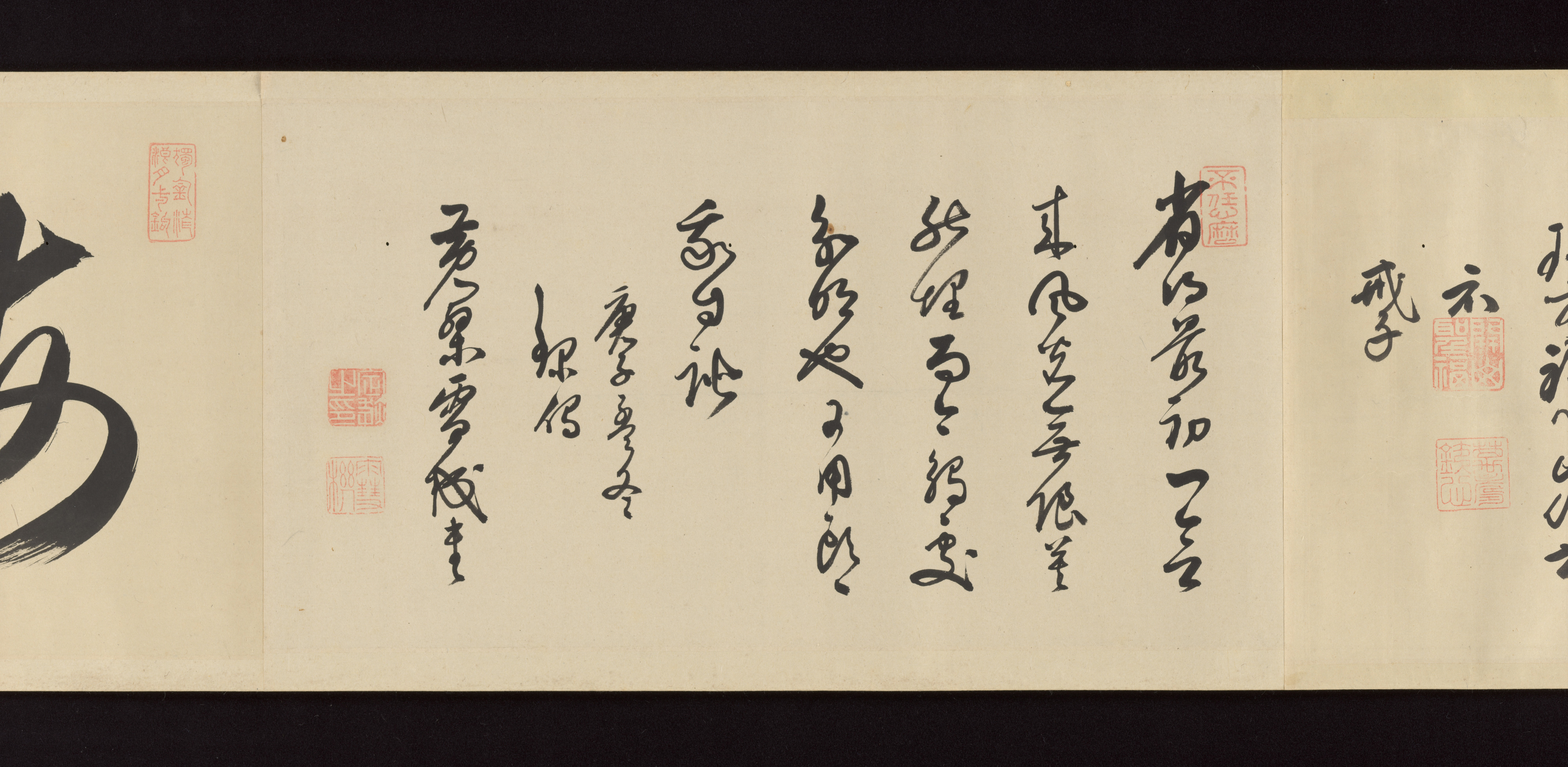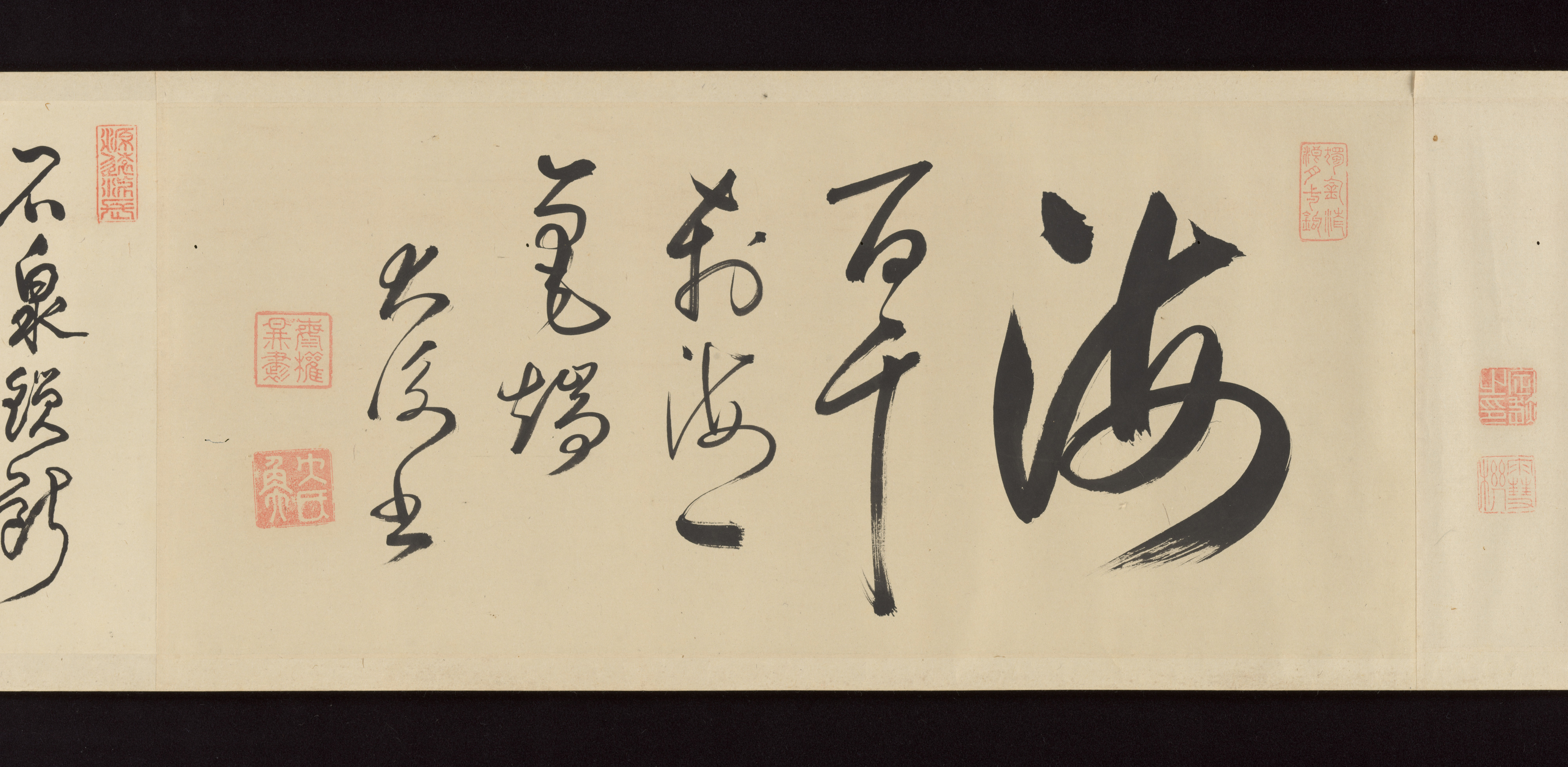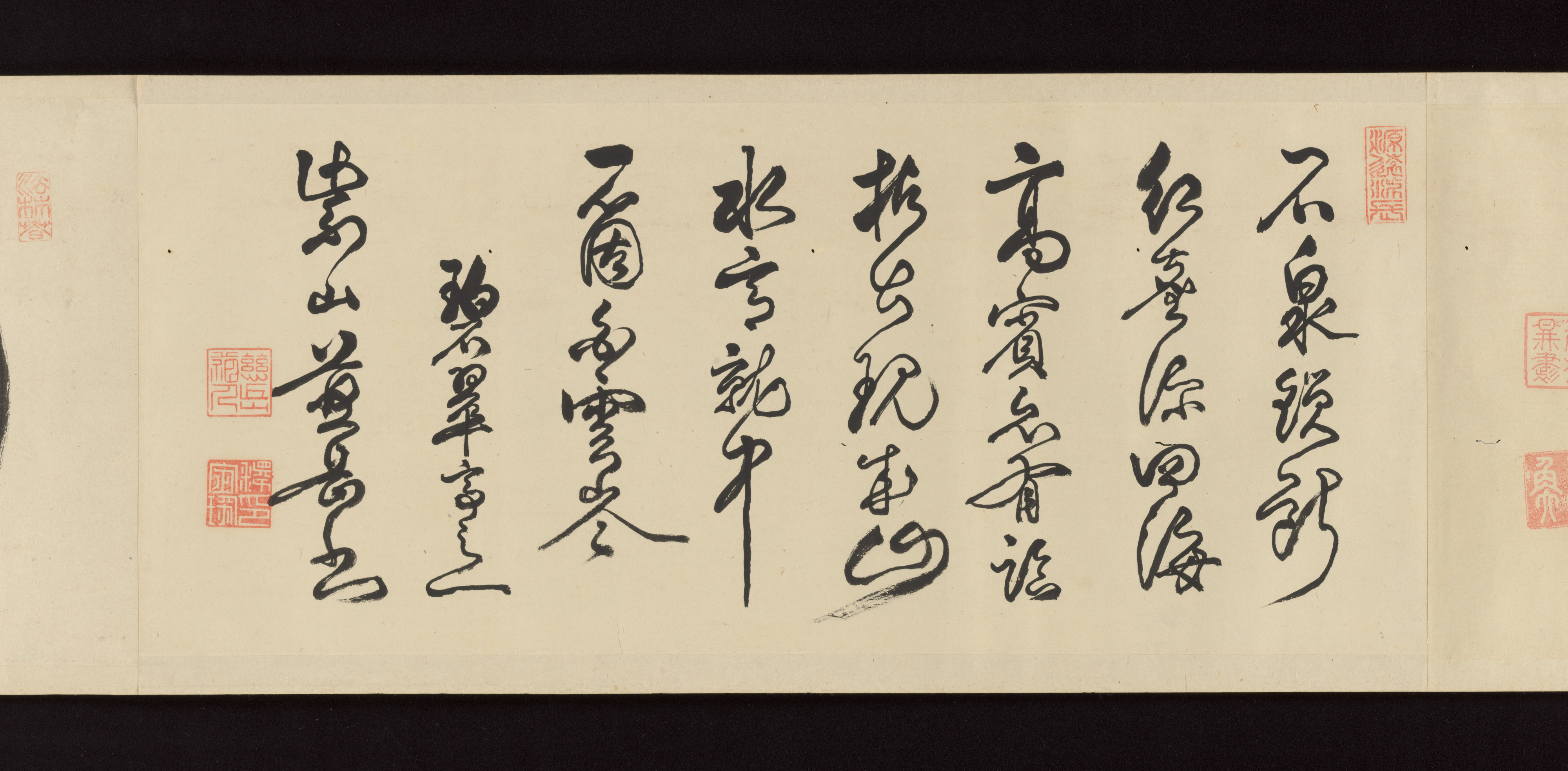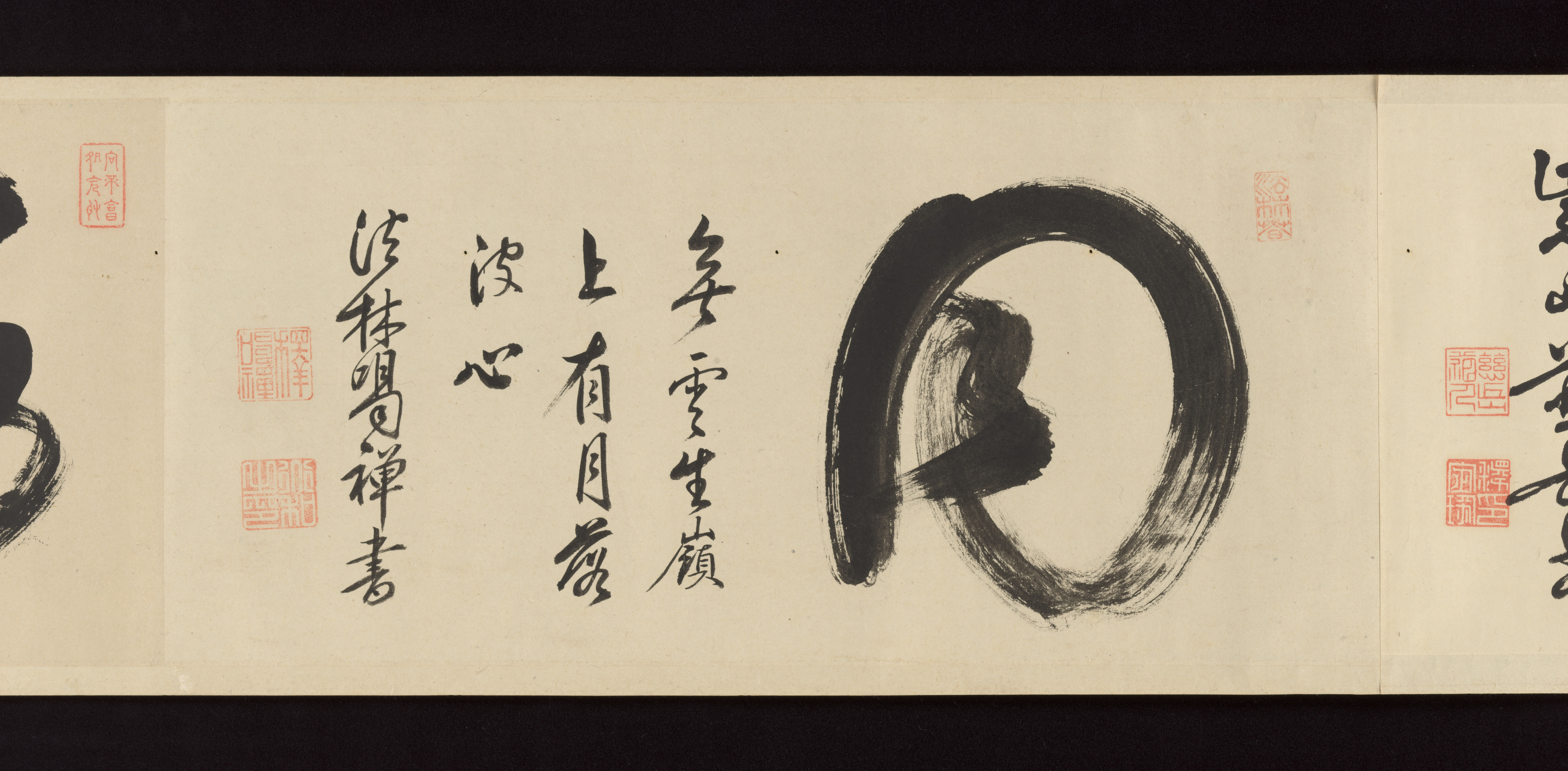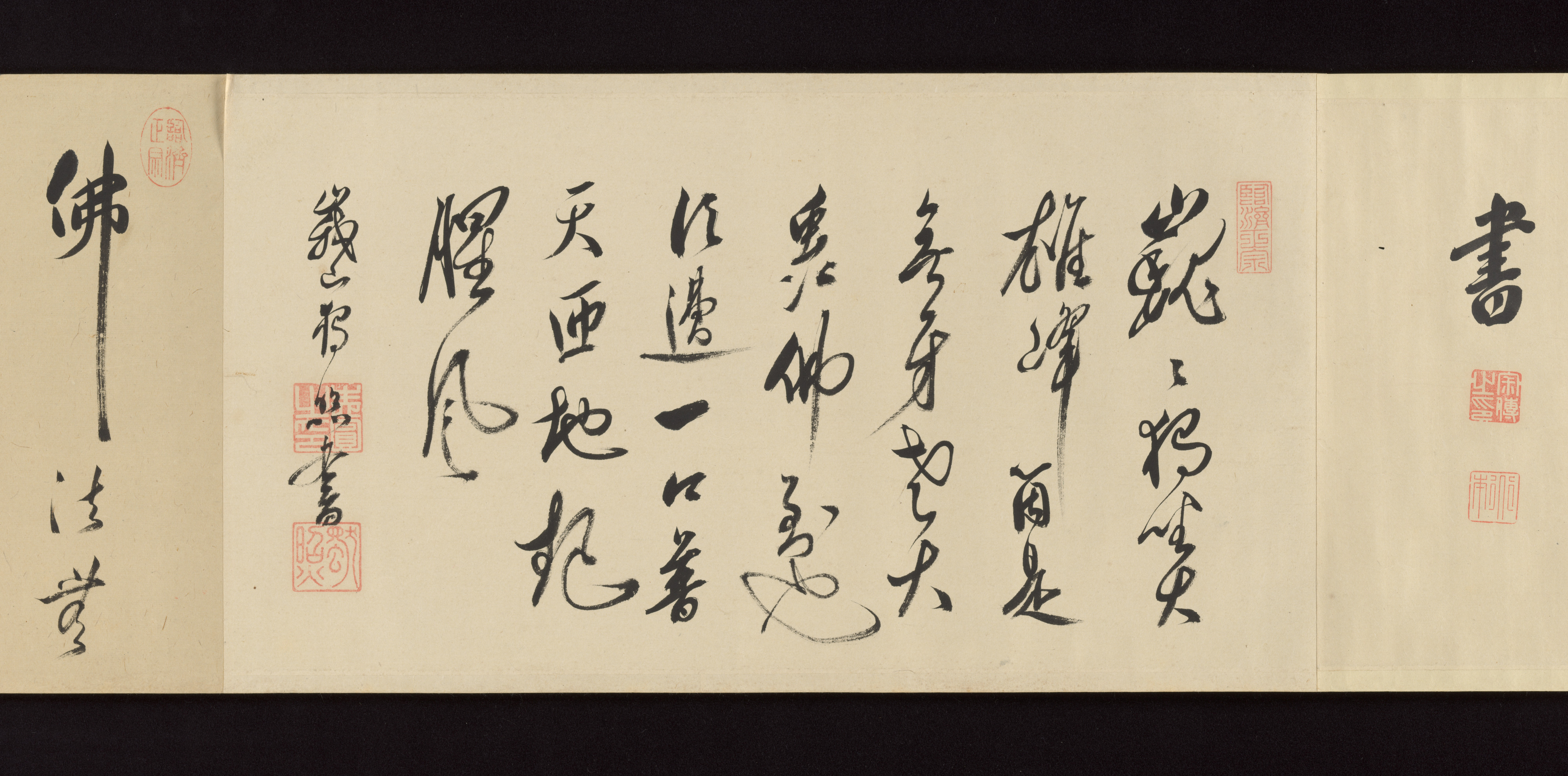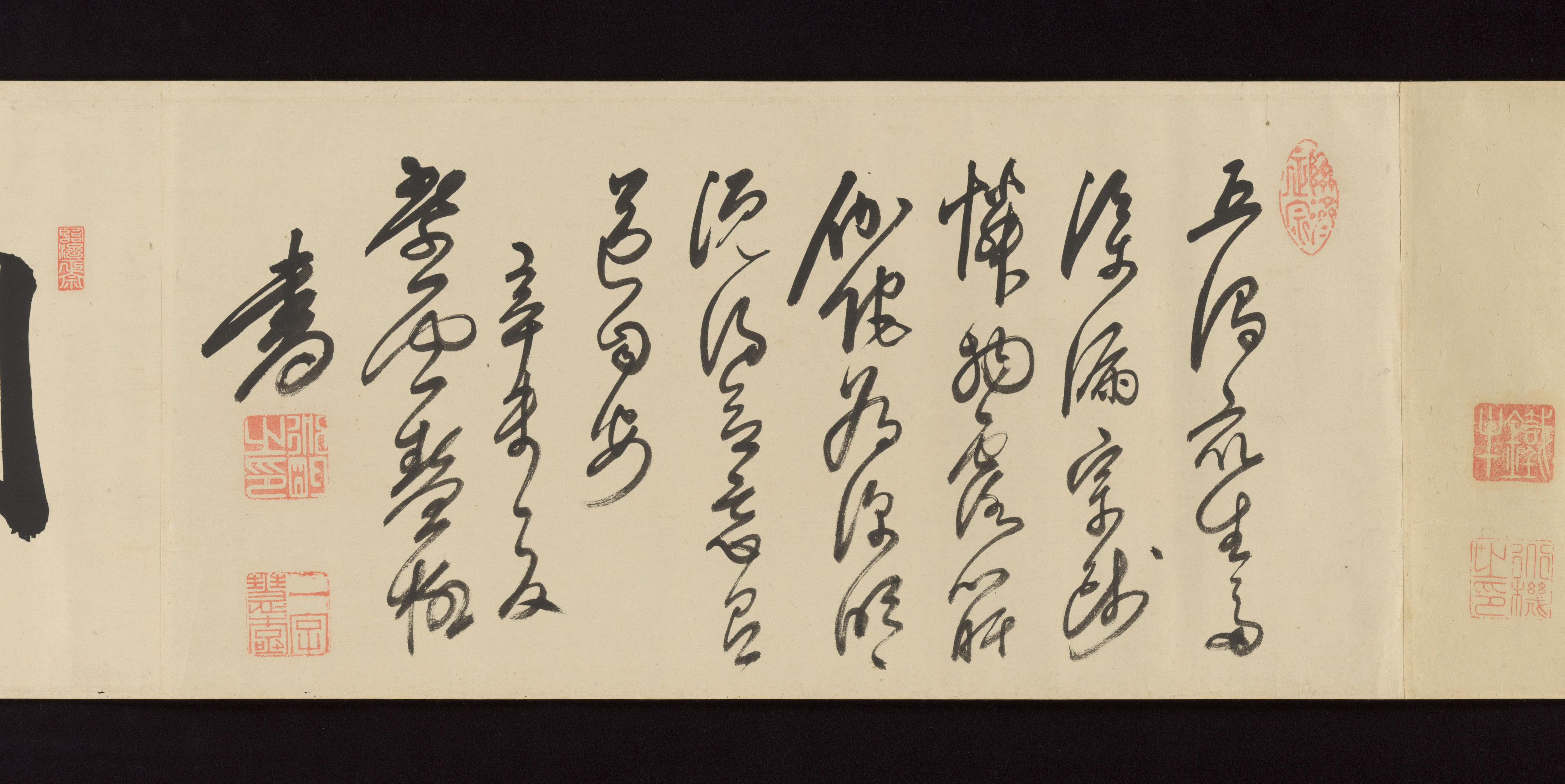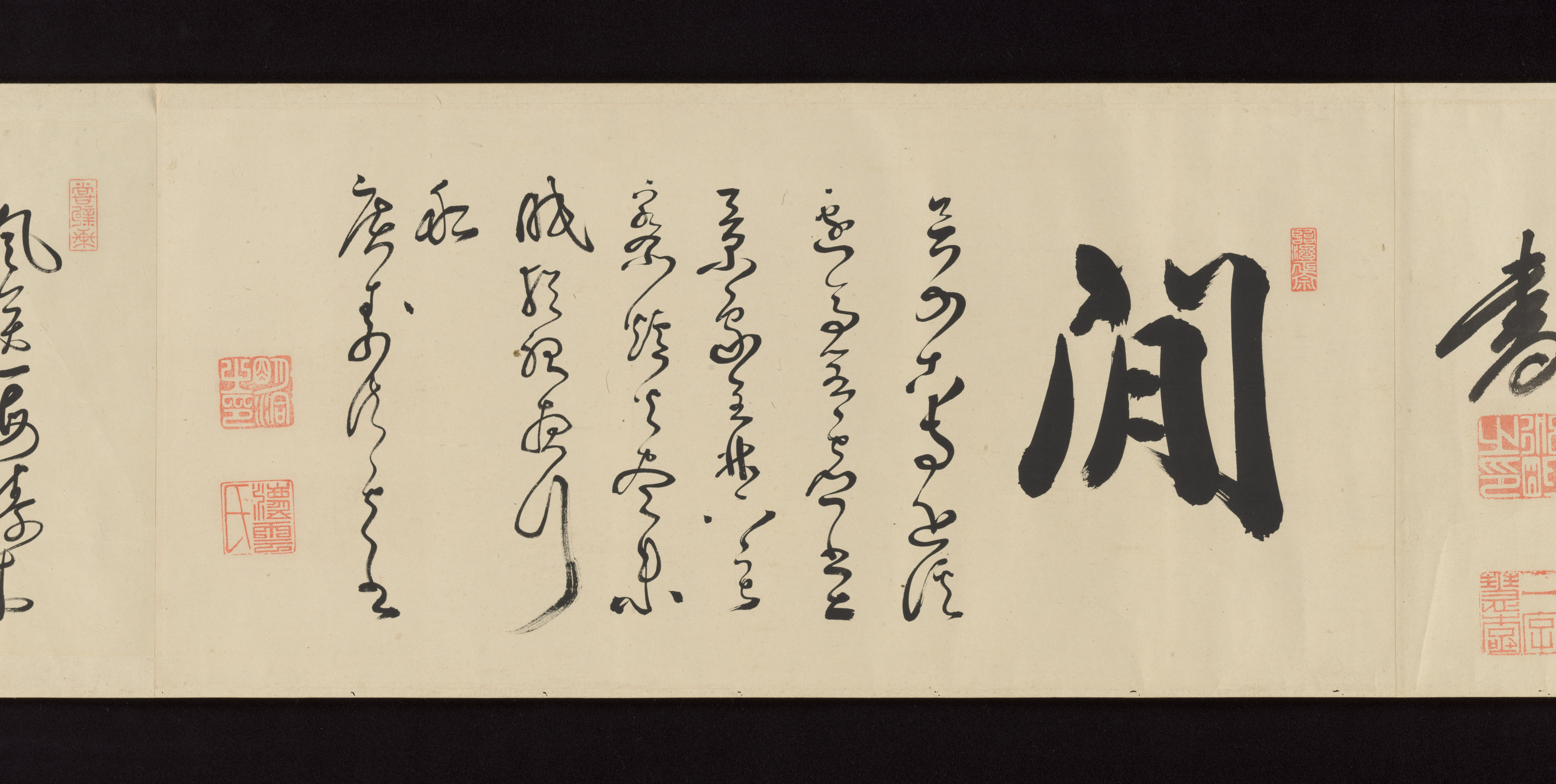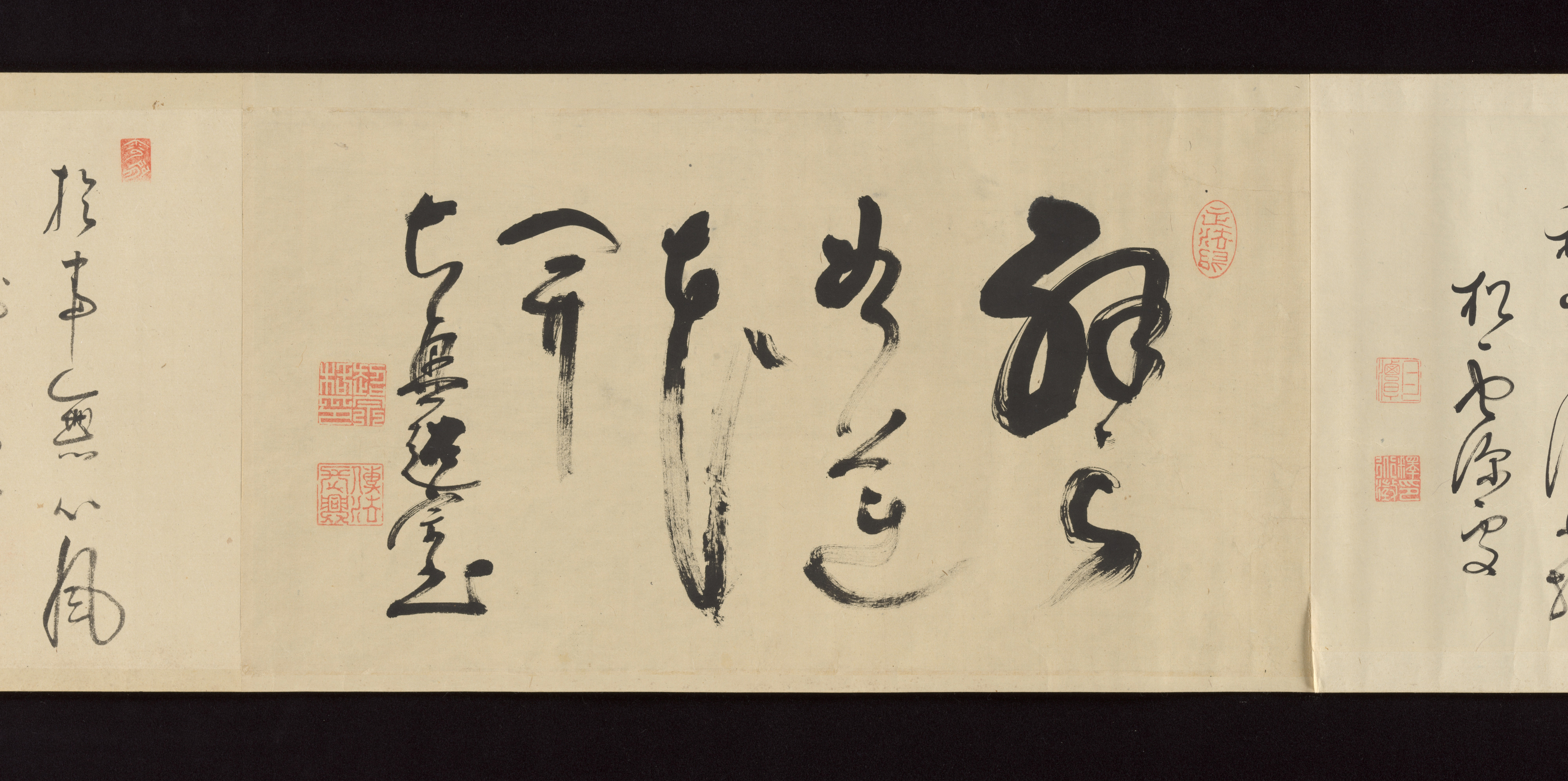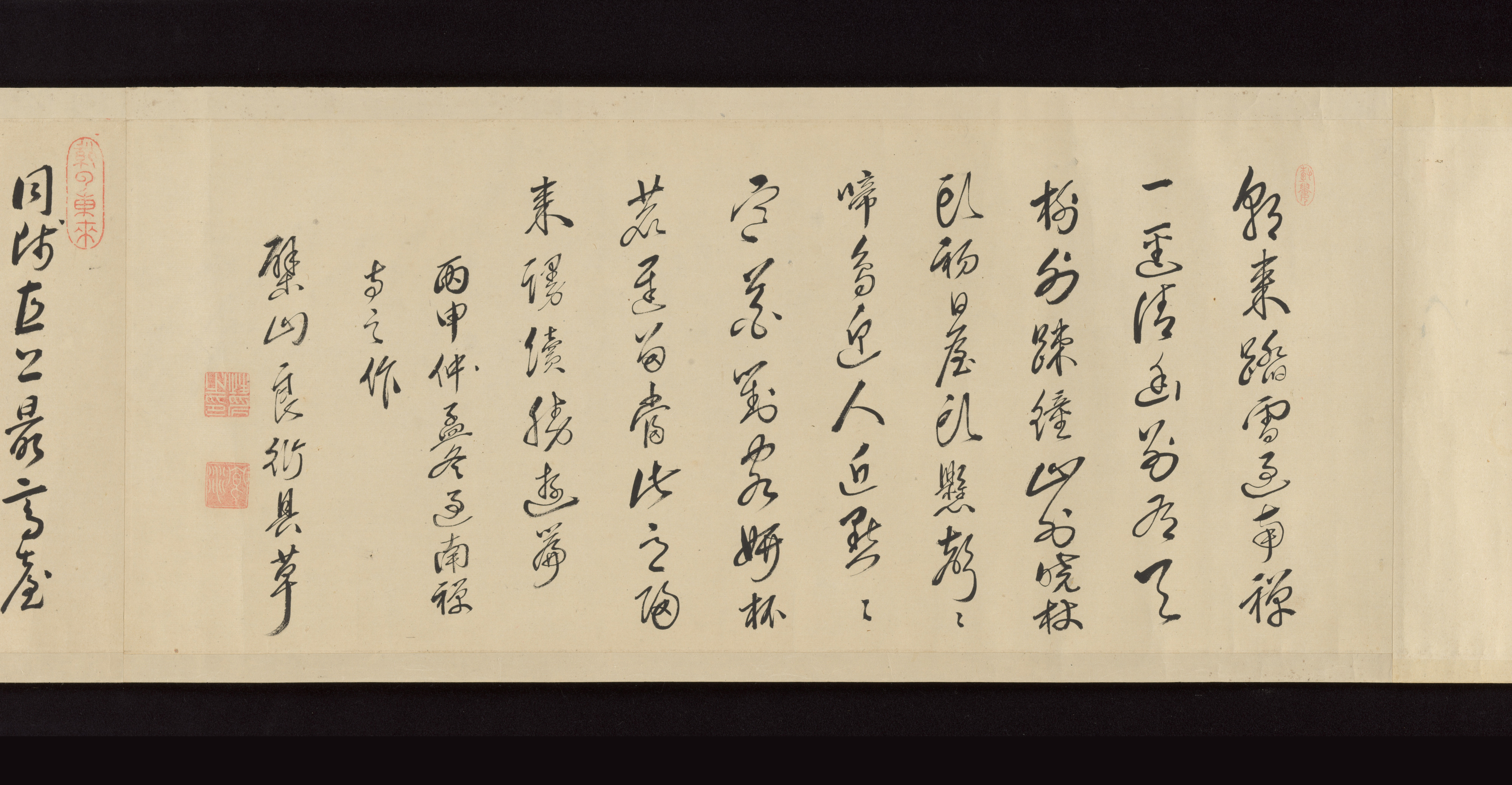Handscroll of Calligraphy by Ōbaku Zen Monks
Yinyuan Longqui (Ingen Ryūki) Chinese
Not on view
The Ōbaku sect of Zen Buddhism was established in Japan in 1661 by a small faction of masters from China and their Japanese disciples, who founded a temple at Manpukuji in Uji, south of Kyoto. From the time they arrived, the Chinese masters were recognized as expert calligraphers. Consequently, Ōbaku monks cultivated the arts of Chinese poetry and calligraphy as a means of promoting Zen teachings. These two handscrolls comprise dynamic calligraphies by forty-two different monks, including nearly all of the most famous émigré masters, and an impressive array of Japanese-born disciples. That these scrolls once belonged to Robert van Gulik (1910–1967)—the celebrated diplomat, popular writer, scholar, and collector of Asian art—adds to their prestige.
LIST OF MONK-CALLIGRAPHERS
Scroll a
1. Yinyuan Longqi (Ingen Ryūki) 隱元隆琦 (Chinese, 1592–1673)
2. Mu’an Xingtao (Mokuan Shōtō) 木庵性瑫 (Chinese, 1611–1684).
3. Huilin Xingji (Erin Shōki) 慧林性機 (Chinese, 1609–1681)
4. Duzhan Xingying (Dokutan Shōkei) 独湛性瑩 (Chinese, 1628–1706),
5. Gaoquan Xingdun (Kōsen Shōton) 高泉性潡 (Chinese, 1633–1695).
6. Qiandai Xing’an (Sengai Shōan) 千呆性侒 (Chinese, 1636–1705)
7. Yueshan Daozong (Etsuzan Dōshū) 悦山道宗 (Chinese, 1629–1709).
8. Lingyuan Haimai (Reigen Kaimyaku) 霊源海脈 (Chinese, 1651–1717)
9. Xuru Lianfang (Kyokunyo Renbō) 旭如連昉 (Chinese, 1664–1719)
10. Duwen Fangbing (Dokumon Hōhei) 獨文方炳 (Chinese, 1656–1725)
11. Gaotang Yuanchang (Kōdō Genchō) 杲堂元昶 (Chinese, 1663–1731)
12. Zhu’an Jingyin (Jikuan Jōin) 竺庵浄印 (Chinese, 1696–1756)
13. Ryōtō Gentō 龍統元棟 (Japanese, 1663–1746/47)
14. Dapeng Zhengkun (Taihō Shōkon) 大鵬正鯤 (Chinese, 1691–1766)
15. Hyakuchi Gensetsu 百癡元拙 (Japanese, 1683–1753)
16. Sogen Genmyō 祖眼元明 (Japanese, 1673–1757)
17. Boxun Zhaohao (Hakujun Shōkō) 伯珣照浩 (Chinese, 1695–1776).
Scroll b
18. Ryōkei Shōsen 龍渓性潜 (Japanese, 1602–1671)
19. Jifei Ruyi (Sokuhi Nyoitsu) 即非如一 (Chinese, 1616–1671)
20. Duhou Xingshi (Dokku Shōshi) 獨吼性獅 (Chinese, 1624–1688)
21. Damei Xingshan (Daibi Shōzen) 大眉性善 (Chinese, 1616–1673).
22. Nanyuan Xingpai (Nangen Shōha) 南源性派 (Chinese, 1631–1692)
23. Wuxin Xingjue (Mushin Shōgaku) 無心正覚 (Chinese, 1613–1671)
24. Weiyi Daoshi (Uitsu Dōjitsu) 惟一道實 (Chinese, 1620–1692)
25. Duli Xingyi (Dokuryū Shōeki) 独立性易 (Chinese, 1596–1672)
26. Boyan Xingjie (Hakugan Shōsetsu) 柏巌性節 (Chinese, 1634–1673)
27. Tesshin Dōhan 鐵心道胖 (Japanese, 1641–1710).
28. Xueji Dingran (Sekki Jōnen) 雪機定然 (Chinese, 1628–?)
29. Daikō Kaikon大衡海権 (Japanese, 1651–1715)
30. Ciyue Dingchen (Jigaku Jōchin) 慈岳定琛 (Chinese, 1632–1689)
31. Hechan Daohe (Katsuzen Dōwa) 喝禅道和 (Chinese, 1634–1707)
32. Helang Fangjing (Katsurō Hōsei) 喝浪方淨 (Chinese, 1663-1706)
33. Daoben Jichuan (Dōhon Jakuden) 道本寂傳 (Chinese, 1664–1731)
34. Dokushō Shōen 独照性円 (Japanese, 1617–1694)
35. Tetsugyū Dōki 鐵牛道機 (Japanese, 1628–1700)
36. Egoku Dōmyō 慧極道明 (Japanese, 1632–1721)
37. Hōun Myōdō 法雲明洞 (Japanese 1636–1708)
38. Gettan Dōchō月潭道澄 (Japanese, 1636–1713)
39. Chōshū Nyokaku 超宗如格 (Japanese, 1638–1717)
40. Kakuhaku Kaiten 鶴搏海天 (Japanese, 1631–1672)
41. Nanyuan Xingpai (Nangen Shōha) 南源性派 (Chinese, 1631–1692)
42. Yunqian Jiewan (Unken Kaiwan) 蘊謙戒琬 (Chinese, 1610–1673)
43. Hyakusetsu Genyō 百拙元養 (Japanese, 1668–1749)
Due to rights restrictions, this image cannot be enlarged, viewed at full screen, or downloaded.
This artwork is meant to be viewed from right to left. Scroll left to view more.
